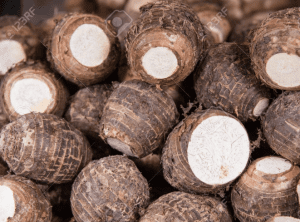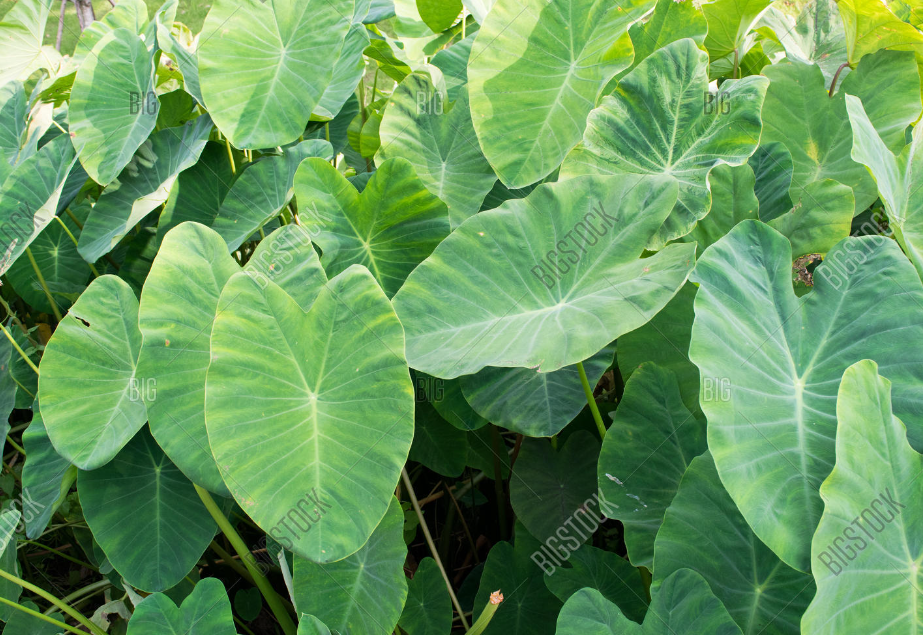Origin Of Cocoyam
Cocoyam originated from tropical America, most probably Central and South America, where the species are believed to have been domesticated from the wild. Cocoyams are herbaceous plants; they belong to the Araceae family and are mostly grown for their edible roots, even though all plant parts are edible.
Cocoyam is listed as invasive in many areas of the world like French Polynesia, Florida, the Galápagos Islands, Puerto Rico, and Costa Rica. It was also introduced to a few other regions, including Africa and Asia.
Colocasia or Xanthosoma genus are the two types of cultivated cocoyam as a food crop. These types of cocoyam generally have a large spherical corm – a swollen underground storage stem, which brings out several large leaves. The petioles of the leaves can be over 1 meter (3.3 ft) long, and they often stand erect.
Tubers (cormels) and suckers (stolons) of cocoyam occur when the corm produces lateral buds. Colocasia varieties may also be called taro, old cocoyam, arrowroot, dasheen, or macabo, while Xanthosoma species may also be referred to as tannia, new cocoyam, yautia, or Chinese taro.
Nutrient Composition Of Cocoyam
Cocoyam is rich in various nutrients such as carbohydrates known as amylose and amylopectin. Cocoyam roots contain a minimal amount of fat and protein relative to cereals and pulses. You can compare the protein level in cocoyam to that of other tropical food such as yam, cassava, etc.
Cocoyam, however, is free from gluten. It contains high-quality phytonutrients such as dietary fiber and antioxidants with other minerals and vitamins in moderate proportion. It is an excellent source of dietary intake; its flesh of 100g gives 4.1 gram or 11% of daily dietary fiber requirement.
Cocoyam contains the following quantity of essential nutrients per 100g:
- Energy 112 cal
- Carbohydrates 26.46g
- Protein 1.50g
- Fat 0.20g
- Dietary Fiber 4.1g
Preferred Botanical Name: Colocasia esculenta
Preferred Common Name: Cocoyam
Local Common Name;
- Ibibio: Ikponn
- Yoruba: Koko
- Igbo: Ede
Medicinal Properties And Uses Of Cocoyam
Cocoyam has a variety of uses, and it has been proven to be effective in the medical field in preventing some ailments. Below are some of the benefits of cocoyam:
Cancer Prevention
Antioxidants in cocoyam root play an active role in the human body, such as boosting the immune system and eliminating dangerous free radicals from the body. The elimination of free radicals, which would have turned into cancerous cells or result in a serious health challenge, guarantees a healthy life.
Vitamin A, Vitamin C, Cryptoxanthin, and other phenolic antioxidants found in taro roots are the nutrients responsible for preventing cancer and other health conditions.
Reduce Symptoms Of Rheumatoid Arthritis
Symptoms of rheumatoid arthritis are linked to low levels of vitamin B6. Cocoyam contains vitamin B6, and is very beneficial to overcome rheumatoid arthritis (RA). A little research has shown that rheumatoid patients require more vitamin B6 due to constant muscle aches and joint pain due to chronic inflammation.
Vitamin B6 supplements help manage aches in the muscles and joints due to arthritis and reduce pain.
Immune System Health
The regular consumption of cocoyam promotes immune system health. Vitamin C is found in Cocoyam roots, which help encourage the immune system to create more white blood cells that help defend the body from foreign pathogens and agents.
Vitamin C also acts as an antioxidant; it lowers the chances of some health conditions such as heart disease and cancer.
Cramps
Cocoyam contains about 615mg of potassium which equals 13.09% of the everyday recommended value. Potassium is linked with reducing muscle cramps and improving muscle strength. Low potassium levels in the body will result in muscle cramps.
Athletes who do not consume foods rich in potassium and are dehydrated before and after sports activities will have muscle cramps.
Digestive Health
Dietary Fiber is present in cocoyam in a high amount such that one serving meets the daily fiber requirement. Dietary fiber is considered to be an important nutrient that aids digestion. Fiber promotes gastrointestinal health, making it an essential nutrient in cocoyam.
Fiber aids bowel movement by helping food move through the digestive tract, implying improved digestion. Fibers also prevent excess gas, bloating, cramping, constipation, and diarrhea.
An individual with a healthy gastrointestinal system may have a reduced chance of different kinds of cancer, and overall health is significantly boosted.
Enhances Learning
Vitamin B1, also known as thiamine, is an essential nutrient in cocoyam. Thiamine is a crucial vitamin for increasing focus and energy, fighting chronic stress, and preventing memory loss. Cocoyam consists of 0.099 mg of vitamin B1, 8.25% of the daily recommended value.
Boosts Vision
As mentioned before, antioxidants such as beta-carotene and cryptoxanthin are present in cocoyam. These antioxidants can help improve vision by preventing the free radicals from attacking ocular cells and causing macular degeneration or cataracts!
Diabetes
Besides proper bowel movement, dietary fiber can also help lower the chances of developing diabetes because it helps regulate the release of insulin and glucose in the body. Regular consumption of cocoyam can help manage glycemic levels and reduce the risk of diabetes.
Fiber-rich foods such as taro root are suitable for a diabetic patient because the hazardous spikes and plunges in blood sugar levels are prevented.
How To Grow Cocoyam
Growing cocoyam requires adequate information, below are detailed explanations on how to grow cocoyam.
Yield Requirements Of Cocoyam
Bigger yields and larger corms of cocoyam result from planting larger suckers and headsets; this also depends on the size of the planting material and the type of cultivars to be grown. Some varieties with big corms may produce two heads from the same corm.
Medium-sized suckers are selected when planting growing tubers for export. Before planting the headsets and suckers, ensure that they are from a healthy plant to protect yields and prevent the spread of diseases.
Soil And Sun Requirements Of Cocoyam
Soil specifications for growing cocoyam are fertile, well-draining, and sandy loam with soil pH between 4.2-7.5. These specifications are most suitable for growing cocoyam, resulting in an excellent yield. Cocoyam can also grow in paddies, wetland areas using a system synonymous with rice.
Sun requirement differs for species; Xanthosoma species require temperatures above 69.8°F (21°C). At the same time, Colocasia species will not thrive in an oversaturated area, and they grow best in well-draining loams with soil pH between 5.5 and 6.5 in partial shade.
Generally, cocoyam will survive full sunlight or partial shade. The plants do not live long in 10°C (50°F) temperatures; instead, lower temperatures will destroy them.
Planting Requirements Of Cocoyam
Plant your cocoyam in a large space and shallow depth to ensure proper growth of the cocoyam sucker. Although a narrow spacing controls weed, large spacing is preferred for adequate growth. Planting space between plants is 30 to 100 cm (11.8 – 39.4 inches) depending on soil type and climate conditions.
Cocoyams are vegetatively propagated from their sucker or headset; they are often planted in furrows or ridges and grow quickly with the highest survival rate. Most cocoyam varieties mature in about eight months from planting.
Harvesting Of Cocoyam
Most cocoyam varieties mature in about 8 months from planting. Harvesting is done by pulling the plant to uproot it and bringing out the cormels while the remains in the soil are dug out. A basket is used to transport the harvested tubers.
Storage And Preservation Of Cocoyam
A cool, dry, and well-ventilated environment is suitable for storing cocoyam. The optimum storage temperature is reported to be 7 degrees Celsius. You can store corms of cocoyam for up to four months. At higher ambient temperatures (25 to 30 degrees Celsius), cocoyams will store only for periods of 4 to 6 weeks without severe losses.
Traditional storage methods include simply heaping the corms under shade or covering them with straw or plantain leaves. Storage in pits is also carried out with the pits covered with leaves and soil.
Pests And Diseases And Control Of Cocoyam
The following are pests and diseases and control of cocoyam:
Alomae-bobone
This is a disease of cocoyam caused by a virus. Its symptoms include shortness of leaf petioles and also developing enations. Leaves thicken, roll, brittle, and become dark green.
Manage the disease by removing any plants showing symptoms and destroying them by burning. Removal of outer leaf sheaths may control the disease by reducing the number of leafhopper eggs.
Dasheen Mosaic
A virus causes this disease. Its symptoms include mosaic patterns on leaves and mild to moderately deformed leaves. You can manage traditionally by planting resistant varieties.
Phytophthora leaf blight
Oomycete causes this, and its symptoms include small purple or dark brown and circular lesions on leaves that may enlarge and coalesce. Planting resistant varieties is the most common method of avoiding this disease.
Remove and destroy symptomatic leaves of the infected plant to lower inoculum level. Plant cocoyam in well-drained soils.
Pythium root and corm rot
Fungi cause this disease. Symptoms include soft, mushy rot on the corm with a foul odor. You can eradicate the root system, planting stunted plants with shortened leaf stalks, curled leaves, crinkled and yellowish.
Pink Hibiscus mealybug
This is an insect that affects cocoyam. Symptoms of infestation include stunted growth of plants at growing tips; leaves may be distorted. Insects are soft-bodied elongated ovals that are pink in color and covered in a white waxy substance. Poring jets of water on plants can be effective in pursuing insects.
Conclusion
Cocoyam, often referred to as a nutritional powerhouse, provides a multitude of health advantages. Bursting with dietary fiber, this tuber has been found to aid in digestion and cultivate a thriving gut. Its low glycemic index also makes it a smart option for individuals seeking to manage their blood sugar levels, particularly those living with diabetes. Jam-packed with essential vitamins and minerals such as vitamin C and potassium, cocoyam bolsters immune function and reinforces a robust cardiovascular system
Furthermore, Cocoyam is full of powerful antioxidants that can combat oxidative stress, lowering the risk of chronic diseases. This versatile tuber has a rich nutritional profile and can be used in various dishes, making it an excellent addition to a well-balanced diet that promotes overall well-being.

